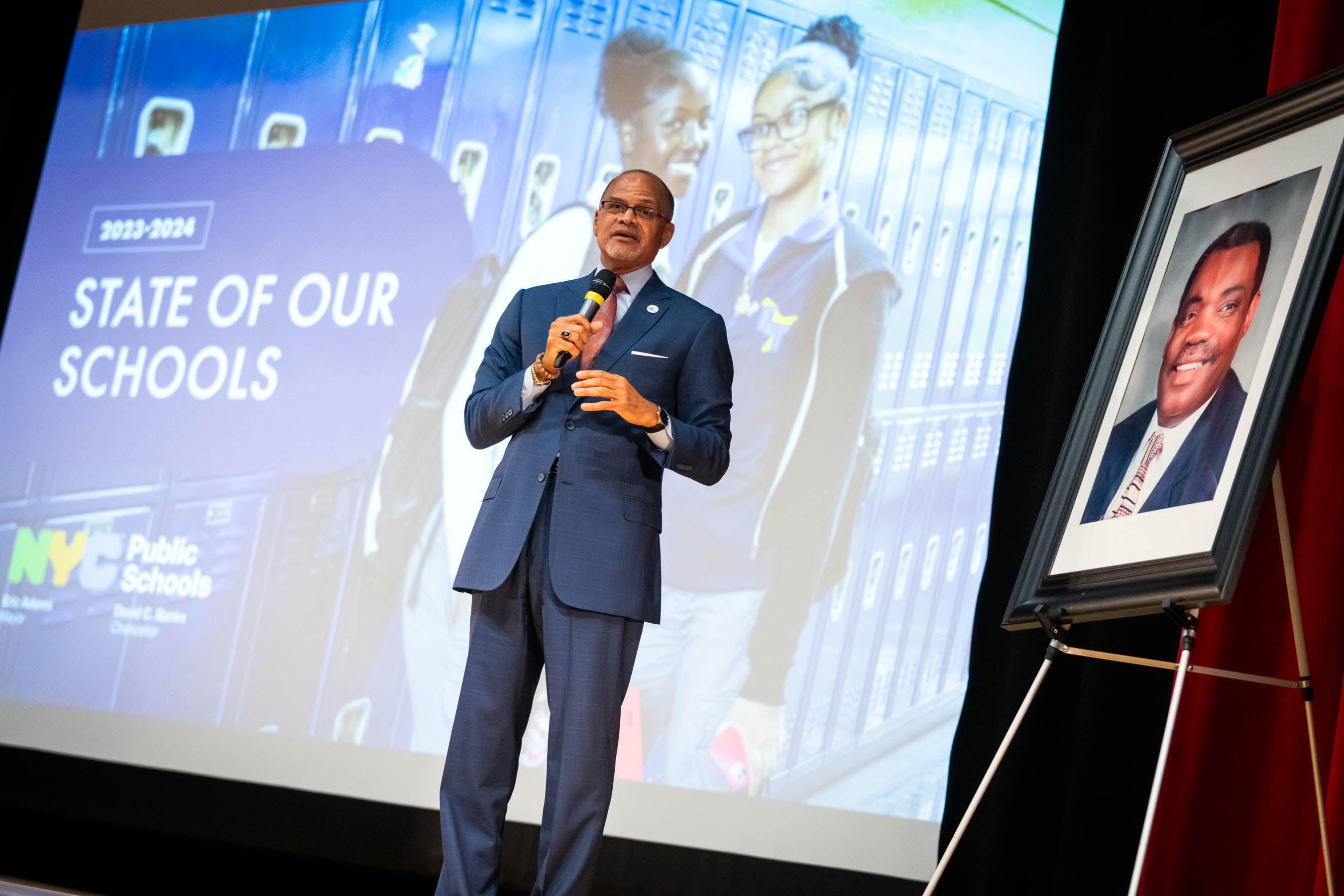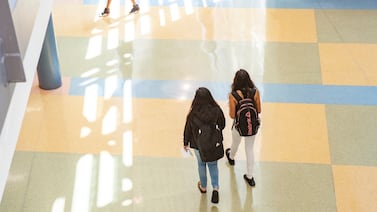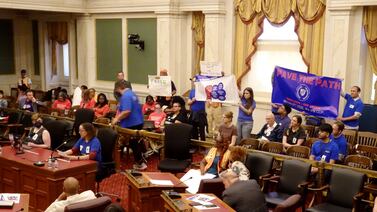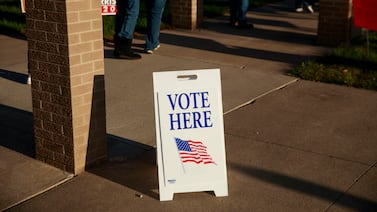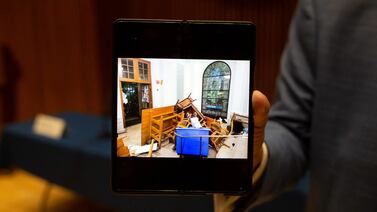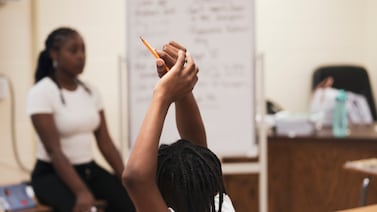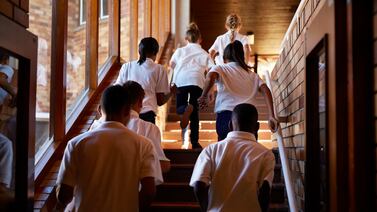Sign up for Chalkbeat New York’s free daily newsletter to keep up with NYC’s public schools.
In his 20 months as chancellor of New York City’s schools, David Banks has repeatedly emphasized the need to boost literacy rates and expose more students to career opportunities before they leave high school.
Those ideas were front and center in a “State of our Schools” address he delivered Wednesday at Bedford-Stuyvesant’s Boys and Girls High School, in an auditorium packed with school staff, administrators, union officials, and parent leaders.
The speech hewed to priorities Banks has repeatedly advanced and provided some insight into how he’d like to expand existing efforts.
A program that gives schools resources to spin up new career tracks and offer early college credit is set to grow next year, he said. And Project Pivot — a $15 million initiative that pairs schools with community organizations that provide counseling, mentorship, and violence interruption — will expand to 250 schools this year, up from 144.
Banks didn’t name any new education initiatives, which could indicate that the chancellor’s focus this year will be on implementing existing programs rather than scaling up new ones. It could also reflect budget constraints, as the city grapples with dwindling federal relief dollars and a new round of budget cuts mandated by City Hall.
Here’s what Banks’ speech did — and didn’t — focus on. We’d also love to hear from you about what you think the chancellor should prioritize. Let us know by filling out this survey.
Literacy, literacy, literacy (and maybe other subjects, too)
Banks’ speech focused on his highest-profile policy initiative: boosting the city’s middling literacy rates by overhauling school reading curriculums. Beginning this fall, elementary schools in nearly half the city’s districts are required to use one of three reading programs — with the rest of schools following a year from now.
For years, principals enjoyed wide latitude to pick their own curriculums — and hundreds selected “balanced literacy” programs that Banks has blamed for poor reading outcomes. During his speech, the schools chief played a video of a student using illustrations to guess the words in a picture book instead of sounding them out, a common element of balanced literacy programs that has been widely discredited.
“That is how we’ve been teaching the kids to read — it’s a completely misguided way,” Banks said. “We are fixing that playbook starting right now.”
Banks signaled that he’s interested in changes beyond elementary school literacy. Already, the city has tapped 250 high schools to use a single algebra curriculum. In a less coordinated effort, some high school superintendents are beginning to institute their own reading program mandates. And early childhood centers are also moving to a uniform curriculum. More curriculum changes could be on the horizon across a range of subjects and grade levels, a process Banks suggested would take years.
“Teachers need more support,” Banks told reporters after the speech. “They need a little bit more of a script of what we’re expecting from them.”
A focus on career and technical programs
Banks framed the event with a philosophical question: “What is the purpose of school?”
Part of the answer, he said, is better-preparing students to enter the workforce, a shift that comes as college enrollment is dipping locally and nationally. This year, 100 high schools are part of a program called FutureReadyNYC that gives schools resources to launch new career tracks and paid work opportunities in education, technology, business, or health care. Officials said they sent about $18 million to those schools to support new programming.
“Historically, too many 12th graders leave our school system with a diploma but not much else,” Banks said. “Our pathways work is rewriting the script.”
Banks said FutureReady will grow by at least half next year, in line with previous promises to expand the program. By 2030, officials also vowed to create plans for every student that outline their postsecondary goals and map out a strategy to achieve them. About 70% of students have similar plans right now, officials said.
The new career tracks created through FutureReady are typically less intensive than state-certified career and technical programs and are easier to quickly scale up, allowing the city to reach more students. However, some observers worry that in an effort to expand those offerings to a wider array of schools, the programming will be less rigorous. (City officials contend that the programming is just as rigorous.)
Principals generally said they’re glad the Education Department is making it easier to set up work-based learning experiences, but it may prove challenging for officials to offer them at a large scale. A department spokesperson said that just over 2,800 students have received paid work opportunities through FutureReady so far.
A separate initiative aims to provide students with paid apprenticeships, and officials have previously said their goal is to offer those opportunities to 3,000 students over three years. About 150 students began apprenticeships last school year and another 257 are expected to start in October, a spokesperson said.
What didn’t get mentioned
Banks’ speech didn’t touch on some of the biggest looming challenges, including a fresh series of budget cuts ordered by Mayor Eric Adams, which could initially require a $700 million reduction to the Education Department’s budget but could exceed $2 billion if the city follows through with all of the planned cuts. The city’s schools are also facing the expiration of billions in federal relief funding, enrollment declines that raise the specter of mergers and closures, and alarming rates of chronic absenteeism.
The federal relief funding has supported a slew of initiatives, including expanded preschool for 3-year-olds, summer school, and hundreds of social workers. It also supports bilingual staff for English learners — a growing need as 26,000 children in temporary housing, many of them new migrants, have enrolled in the school system over the past year and half, Banks said.
Taking questions from reporters, Banks said decisions about cuts have not yet been made.
“Anytime you’re talking about cuts of that magnitude, it’s going to impact some of the programs that we already have in place,” Banks said.
The chancellor added that the department hopes to avoid slashing school budgets and will prioritize the city’s literacy and career pathways initiatives.
“That’s where we’re going to be making sure that the investments are still there,” he said.
This story has been updated with additional responses from the Education Department, which were provided days after this story was published.
Alex Zimmerman is a reporter for Chalkbeat New York, covering NYC public schools. Contact Alex at azimmerman@chalkbeat.org.


